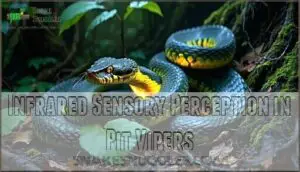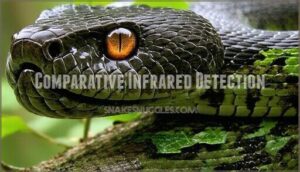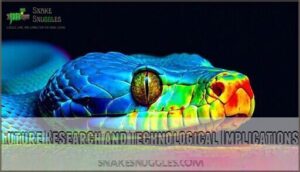This site is supported by our readers. We may earn a commission, at no cost to you, if you purchase through links.

These organs contain thousands of nerve endings that instantly convert infrared radiation from warm-blooded prey into electrical signals your brain would envy for speed.
When you consider how these snakes hunt in complete darkness, you’re witnessing evolution’s masterpiece—they create detailed heat maps of their surroundings, pinpointing a mouse’s location or a bird’s breathing pattern from several feet away.
The science behind their infrared detection reveals fascinating secrets about nature’s most sophisticated thermal hunters, and how these snakes can detect prey through infrared radiation and create detailed heat maps.
Table Of Contents
- Key Takeaways
- Pit Vipers’ Heat-Sensing Mechanism
- Evolutionary Adaptations in Heat Sensing
- Infrared Sensory Perception in Pit Vipers
- Comparative Infrared Detection
- Future Research and Technological Implications
- Frequently Asked Questions (FAQs)
- Can pit vipers sense heat?
- What snake has heat-sensing abilities?
- What are the special features of the pit viper?
- Why is it beneficial for pit vipers to see infrared light?
- Do pit vipers use heat sensing for navigation?
- Are there any predators of pit vipers utilizing heat?
- What are the health effects of damaged pit organs?
- Do pit vipers hunt during winter months?
- How do weather conditions affect heat sensing?
- What predators threaten pit vipers in nature?
- Conclusion
Key Takeaways
- You’ll find pit vipers can detect temperature differences as small as 0.003°C through specialized pit organs located between their eyes and nostrils, containing thousands of TRPA1 ion channels that instantly convert infrared radiation into electrical signals.
- You can observe these snakes hunting in complete darkness by creating detailed thermal maps of their surroundings, pinpointing warm-blooded prey from several feet away with surgical precision using their built-in thermal cameras.
- You’ll discover that heat-sensing abilities evolved independently in three snake families—pit vipers, boas, and pythons—through convergent evolution, with pit vipers developing the most advanced system featuring deeply recessed organs.
- You’re witnessing scientists transform pit viper research into breakthrough technologies, from bioinspired pyroelectric materials that convert heat to electricity to advanced infrared sensors for medical imaging and military applications.
Pit Vipers’ Heat-Sensing Mechanism
You’ll find pit vipers equipped with specialized organs between their eyes and nostrils that detect infrared radiation from warm-blooded prey.
These heat-sensing pits contain thin membranes packed with TRPA1 ion channels, which convert thermal energy into electrical signals your brain can process within seconds, utilizing TRPA1 ion channels.
Nature’s thermal cameras: pit vipers transform infrared heat into instant electrical signals through specialized TRPA1 channels.
Pit Organs Structure and Function
Two specialized pit organs positioned between your pit viper’s eyes and nostrils function as biological heat detectors.
These organs contain an ultra-thin membrane with remarkable thermosensitivity, suspended over an air-filled cavity that provides thermal insulation.
The membrane houses thousands of nerve endings for directional perception, while membrane vascularization enhances sensitivity to infrared receptors during thermoreception.
- Pinpoint accuracy in prey detection
- TRPA1 ion channels
- Evolution insights into thermosensation
- Enhanced nerve adaptation
Ion Channels in Pit Membrane
Within the pit organ’s thin membrane, you’ll find thousands of specialized TRPA1 ion channels acting like molecular thermometers.
Nature’s most sophisticated heat detectors lie hidden between a pit viper’s eyes and nostrils.
These heat-sensitive ion channels detect temperature changes as small as one-thousandth of a degree, transforming infrared radiation into electrical signals.
High channel density amplifies even minor thermal variations, while rapid adaptation speed prevents sensory overload, ensuring your pit viper maintains continuous thermal detection capabilities.
This remarkable ability stems from the snake’s thermosensory-driven behaviors linked to TRPA1.
Transmission of Electric Signals to The Brain
Your pit viper’s heat detection relies on lightning-fast signal transduction through specialized neural pathways.
Once TRPA1 channels generate electric signals, they race along sensory nerve fibers toward the brain.
This synaptic transmission enables rapid brain integration of thermal data.
Advanced sensory processing creates detailed brain mapping, ensuring perception accuracy that transforms infrared radiation into precise hunting coordinates within milliseconds.
Evolutionary Adaptations in Heat Sensing
You’ll discover that heat-sensing abilities evolved independently in three different snake families, creating remarkably similar thermal detection systems through separate evolutionary paths.
These adaptations give pit vipers, boas, and pythons distinct advantages in hunting warm-blooded prey, with each group developing unique anatomical structures that enhance their survival in various environments.
Common Traits Among Pit Vipers, Boas, and Pythons
Through convergent heat-sensing evolution, you’ll find that pit vipers, boas, and pythons developed remarkable thermal imaging abilities independently.
These snake senses showcase stunning pit morphology adaptations for infrared vision across different families.
- Sensory integration combines heat detection with visual and chemical cues for enhanced hunting strategies
- Nocturnal predation becomes highly effective through specialized heat detection systems
- Parallel evolution produced similar thermal capabilities despite distinct anatomical origins
Pit vipers use their pits to facilitate precise prey location.
Anatomical Variations in Heat-sensitive Organs
While these three snake families share heat-sensing abilities, their pit morphology varies dramatically.
You’ll find pit vipers sport deeply recessed loreal pits between their eyes and nostrils, housing ultra-thin membranes packed with high receptor density.
Boas feature multiple labial pits along their jaws with moderate membrane thickness, while pythons display numerous smaller pits with thicker membranes.
Each air chamber design and vascularization pattern reflects different nerve endings arrangements, creating unique thermal detection capabilities. This allows them to detect minute changes via the TRPA1 protein activation, which is made possible by the TRPA1 protein and enables minute changes detection, showcasing the importance of unique thermal detection.
Hunting Strategies and Survival Benefits
You’ll find that pit vipers excel at nocturnal predation using thermal navigation to locate warm-blooded prey.
Their hunting strategies enable precise prey targeting in complete darkness, giving them significant predator avoidance advantages.
These survival strategies also support thermoregulation by helping snakes find cooler resting spots.
This nocturnal hunting ability transforms pit vipers into efficient nighttime predators with unmatched prey detection capabilities.
Infrared Sensory Perception in Pit Vipers
You can observe pit vipers detecting warm-blooded prey through specialized infrared sensors that work like natural heat-seeking cameras, allowing these snakes to hunt effectively in complete darkness.
These remarkable sensory organs convert thermal radiation from mammals and birds into electrical signals, which the snake’s brain processes within seconds to create a precise thermal map of its surroundings, using this information to locate warm-blooded prey.
Detection of Prey Using Infrared Radiation
Thermal accuracy becomes your secret weapon when you’re a pit viper hunting in darkness.
Your specialized pit organs detect infrared radiation from warm-blooded animals, enabling precise prey detection even during nocturnal hunting sessions.
Environmental factors like wind or vegetation can’t hide your target’s heat signature.
This strike precision allows you to locate prey several meters away, making you a formidable predator regardless of lighting conditions.
Integration of Thermal Imaging for Hunting
When you watch a pit viper hunt, you’re witnessing nature’s most sophisticated thermal imaging system in action.
These snakes don’t just detect heat—they create detailed thermal maps of their surroundings, pinpointing prey with surgical precision.
- Nocturnal predation: Hunt effectively in complete darkness using thermal imaging
- Spatial location: Create 3D heat maps for accurate prey targeting
- Environmental factors: Adapt hunting strategies based on temperature variations
Nerve Signal Transmission for Heat Perception
After capturing thermal images, pit vipers rely on specialized sensory nerve fibers to carry electric signals from their pit organs.
These neural pathways amplify weak nerve impulses through signal processing centers in the brain.
Brain mapping reveals how thermal perception integrates with visual data, creating a complete sensory picture that guides precise strikes with remarkable accuracy.
Comparative Infrared Detection
You’ll discover that pit vipers aren’t the only snakes with heat-sensing abilities, as boas and pythons also detect infrared radiation through specialized organs.
When you compare these three snake families, you’ll notice that pit vipers have developed the most advanced thermal detection system, with deeply recessed pit organs that provide precise targeting capabilities unlike the simpler labial pits found in their relatives.
Unique Features of Pit Vipers’ Infrared Perception
What sets pit vipers apart? Their membrane dynamics create unmatched thermal resolution.
TRPA1 channels in pit organs detect infrared radiation with incredible precision, enabling directional perception of heat sources.
Unlike other infrared-detecting creatures, pit vipers avoid sensory overload through rapid channel adaptation.
This thermal sensitivity system provides split-second infrared detection, making them nature’s most sophisticated heat-seeking predators.
Comparison With Other Infrared-detecting Animals
Infrared-detecting animals showcase remarkable sensory convergence, yet their mechanisms vary dramatically.
While pit vipers dominate thermal imaging precision, other creatures adapted unique approaches to heat perception.
- Beetle infrared systems help fire-chasing species locate forest blazes for breeding opportunities
- Mammalian IR detection appears in vampire bats using modified heat-sensitive molecules
- Fish thermoreception and avian heat sensing demonstrate widespread animal perception adaptations
Evolutionary Advantages of Infrared Sensitivity
You’ll find that infrared sensitivity transforms pit vipers into nighttime hunters extraordinaire.
Nocturnal predation becomes their specialty, giving them evolutionary advantages over competitors.
This environmental adaptation enables precise prey targeting in complete darkness, helping maintain population balance in ecosystems.
Thermoregulation benefits also emerge, as snakes locate ideal temperature zones.
Prey capture success rates skyrocket when darkness falls.
Their forked tongues also enhance chemical signal analysis.
Future Research and Technological Implications
You’ll discover how scientists are transforming pit viper heat-sensing mechanisms into cutting-edge technologies, from advanced thermal imaging systems to biomimetic materials with pyroelectric properties.
Researchers are now exploring how these snakes’ remarkable TRPA1 ion channels can inspire next-generation infrared detectors that could revolutionize fields ranging from medical diagnostics to military surveillance.
Applications in Artificial Materials With Pyroelectric Properties
Scientists are transforming pit viper research into breakthrough pyroelectric materials that convert heat into electricity.
These bioinspired innovations create smart sensors and thermal detectors with remarkable sensitivity. You can even purchase pyroelectric smart sensors for various applications.
Here’s how artificial materials revolutionize technology:
- Energy harvesting systems capture ambient heat for self-powered devices
- Military applications enhance night vision and target detection capabilities
- Infrared sensors improve medical imaging and environmental monitoring
- Thermal imaging advances boost search-and-rescue operations substantially
Potential for Technology Mimicking Snakes’ Heat-sensing Abilities
Engineers are developing bioinspired technology that copies pit vipers’ incredible heat-sensing abilities.
These advanced sensors could revolutionize search & rescue operations, medical imaging, and thermal camouflage systems.
Artificial heat-sensing materials now mimic snake pit organs, creating enhanced thermal imaging systems for military and civilian applications.
You’ll soon see technology mimicking snake abilities in everyday devices.
You can even find various sensor products inspired by this technology.
Exploration of Heat Perception Advancements
Beyond current capabilities, heat perception advancements promise revolutionary breakthroughs in both biological understanding and technological innovation.
You’ll witness exciting developments that bridge nature’s solutions with human engineering needs. The viper’s pit organs contain TRPA1 protein sensors.
- Neuron adaptation studies revealing how pit vipers process thermal signals instantaneously
- Artificial mimicry of snake infrared detection systems for advanced sensors
- Pyroelectric materials development inspired by serpentine thermal perception mechanisms
- Energy applications harnessing heat-sensing principles for sustainable power generation
- Thermal imaging enhancements revolutionizing medical diagnostics and security systems
Frequently Asked Questions (FAQs)
Can pit vipers sense heat?
Yes, you’ll find pit vipers can detect infrared radiation through specialized organs between their eyes and nostrils.
These heat-sensing pits help them hunt warm-blooded prey in complete darkness with remarkable precision.
What snake has heat-sensing abilities?
Like nature’s thermal goggles, you’ll find three snake families equipped with heat-sensing superpowers: pit vipers, boas, and pythons.
These serpents detect infrared radiation through specialized pit organs, giving them deadly accuracy when hunting warm-blooded prey.
What are the special features of the pit viper?
You’ll find pit vipers possess remarkable infrared detection through specialized pit organs between their eyes and nostrils.
These heat sensors detect temperature differences as small as 001°C, enabling precise nocturnal hunting.
Why is it beneficial for pit vipers to see infrared light?
Ever wonder how you’d hunt if you couldn’t see?
Infrared vision lets you detect warm-blooded prey in complete darkness, strike with deadly accuracy, and find cooler spots for thermoregulation—giving you a serious survival advantage.
Do pit vipers use heat sensing for navigation?
Pit vipers don’t primarily use heat sensing for navigation like compass directions.
Instead, you’ll find they use their infrared detection to locate warm-blooded prey, find cooler resting spots, and avoid predators in darkness.
Are there any predators of pit vipers utilizing heat?
Several predators don’t exploit pit vipers’ heat-sensing abilities directly.
However, birds of prey like hawks and eagles hunt them during daylight when thermal detection offers less advantage, effectively bypassing their infrared sensing capabilities.
What are the health effects of damaged pit organs?
Damaged pit organs severely compromise your snake’s hunting ability, making prey detection nearly impossible in darkness.
You’ll notice reduced feeding success, increased stress, potential malnutrition, and greater vulnerability to environmental threats and predators.
Do pit vipers hunt during winter months?
How do these serpents survive winter’s harsh grip?
You’ll discover pit vipers become largely dormant during winter months, entering brumation where they rarely hunt, conserving energy until warmer temperatures return to reactivate their hunting behaviors.
How do weather conditions affect heat sensing?
Weather conditions substantially impact your ability to detect heat signatures.
Cold temperatures reduce thermal contrast between prey and surroundings, while humidity and wind can disperse heat signals, making detection more challenging but not impossible, due to the impact of these factors on heat signatures.
What predators threaten pit vipers in nature?
You’ll encounter hawks, eagles, falcons, and larger carnivorous mammals like weasels threatening pit vipers . Mongooses, herons, storks, and larger snakes also prey on them, especially targeting younger individuals.
Conclusion
Nature’s thermal detectives continue to amaze scientists with their precision hunting abilities.
Pit viper heat sensing capabilities represent millions of years of evolutionary refinement, creating biological infrared systems that outperform many human technologies.
You’ve discovered how these snakes transform invisible heat signatures into actionable hunting data through specialized pit organs and lightning-fast neural processing.
As researchers discover more secrets about these remarkable thermal sensors, we’re gaining insights that could revolutionize infrared detection technology and deepen our understanding of sensory evolution.















